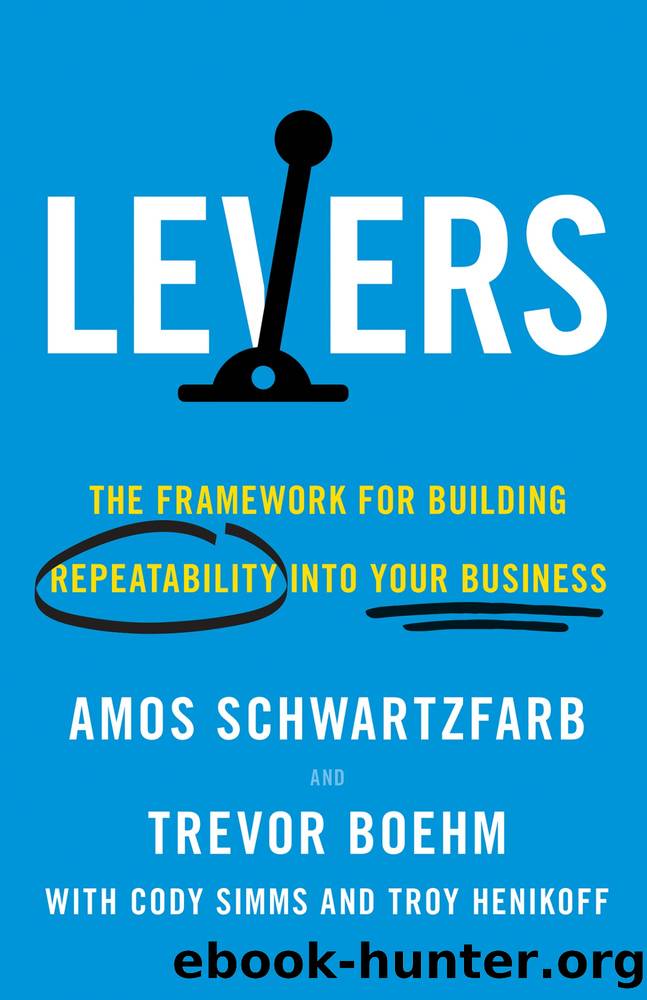Levers: The Framework for Building Repeatability Into Your Business by Amos Schwartzfarb & Trevor Boehm

Author:Amos Schwartzfarb & Trevor Boehm [Schwartzfarb, Amos & Boehm, Trevor]
Language: eng
Format: epub
Tags: Business & Economics, Development, Business Development, Entrepreneurship
ISBN: 9781544519807
Google: OetlzgEACAAJ
Publisher: LIONCREST PUB
Published: 2021-04-20T23:45:04.981915+00:00
Figure 3.13
This learning roadmap aligns really well with todayâs agile and lean startup product development methodologies.
In the past, when developing product to get a CD-ROM on a truck, the waterfall style, the name for a linear approach to designing, building, and shipping products was appropriate. You needed to optimize for having a finite set of features to be complete by a set date that was often months or quarters away. Product roadmaps were actually signed off by sales, marketing, engineering, QA, design, and so on, and then the product went from product management to design to engineering to QA to production in a straight line. Thatâs why it was called waterfall.
In todayâs interconnected world, we can get customer feedback in parallel with product development. This has led to a product development world where we can have deeper confidence that what weâre building today will resonate with customers but with much less fidelity on what exactly we may be building two quarters from now. And thatâs okay.
For some reason, our roadmapping process today still tends to be more of a waterfall-looking document, but it doesnât have to be. Rather than defining arbitrary things we hope to ship two quarters from now, we can define what we hope to learn two quarters from nowâwhatâs really important to know about our business in the futureâand how we plan to learn it.
All of this holds true at the feature level as well. Stop thinking about prioritizing features and start thinking about prioritizing assumptions that need to be validated. As I said previously, I believe the biggest risk founders take is the day they start their business. From then on, the best founders are the ones who out-execute the market by reducing waste and being faster than anyone else at figuring out what the market wants.
Remember, if you donât have data, you only have hope. And you arenât taking on the risk of entrepreneurship because you hope it is going to work. Hope isnât a strategy. Your goal as a founder is to put as much in your own control as possible. If you get good at data-led planning, you gain a much greater hit rate when developing successful offerings that the market wants.
Download
This site does not store any files on its server. We only index and link to content provided by other sites. Please contact the content providers to delete copyright contents if any and email us, we'll remove relevant links or contents immediately.
Zero to IPO: Over $1 Trillion of Actionable Advice from the World's Most Successful Entrepreneurs by Frederic Kerrest(4223)
Machine Learning at Scale with H2O by Gregory Keys | David Whiting(4087)
Never by Ken Follett(3756)
Harry Potter and the Goblet Of Fire by J.K. Rowling(3756)
Ogilvy on Advertising by David Ogilvy(3481)
Shadow of Night by Deborah Harkness(3277)
The Man Who Died Twice by Richard Osman(2977)
Book of Life by Deborah Harkness(2850)
0041152001443424520 .pdf by Unknown(2766)
Will by Will Smith(2766)
My Brilliant Friend by Elena Ferrante(2758)
How Proust Can Change Your Life by Alain De Botton(2725)
The Tipping Point by Malcolm Gladwell(2688)
Purple Hibiscus by Chimamanda Ngozi Adichie(2618)
How to Pay Zero Taxes, 2018 by Jeff A. Schnepper(2577)
Hooked: A Dark, Contemporary Romance (Never After Series) by Emily McIntire(2480)
Rationality by Steven Pinker(2269)
Borders by unknow(2204)
Can't Hurt Me: Master Your Mind and Defy the Odds - Clean Edition by David Goggins(2136)
